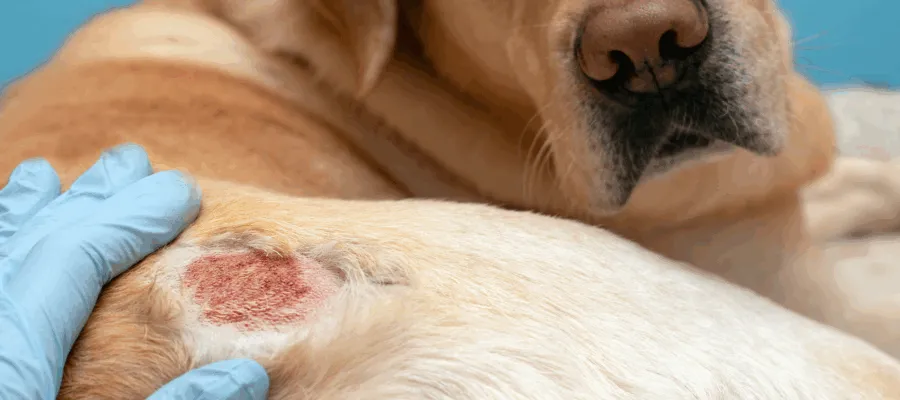Dog Ear Infection or Dog Allergies?
Posted - May 29, 2025

By Carol Bryant, Professional Pet Blogger
Your dog starts pawing at their ear, but what could it be? Is it a dog ear infection or allergies? Could something be stuck in your dog’s ear (like a foxtail), or is that waxy, dirty debris irritating their ear canal?
May is Better Hearing Month, but ZYMOX celebrates healthy ears in pets all year long. Distinguishing between a dog ear infection and allergies can be tricky, as both present with similar symptoms. However, knowing the differences can help identify the root issue and guide you to effective, soothing treatment.
In this article, we’ll explore the differences between dog allergies and ear infections, including their causes, symptoms, and how to treat them. You’ll also find tips for preventing future issues using products like dog ear cleaners for yeast, wipes for dogs’ ears, and dog skin treatment products.
Dog Ear Infection Symptoms
As a dog mom to Cocker Spaniels for over thirty years, I’ve dealt with more than a few ear infections. Consistent ear care is much easier than treating a recurring infection. Here are some signs that your dog might be suffering from an ear infection:
- Redness or swelling in the ear canal
- Noticeable odor that tends to smell funky or yeasty (dogs ears smell)
- Brown, yellowish, or bloody discharge
- Pain or growling when ears are touched
- Head tilting or balance issues
- Excessive head shaking or scratching
During a Pet King Brands webinar, I learned from Julia E. Miller, DVM, DACVD—an expert in veterinary dermatology—how to treat a dog ear infection effectively.
Dr. Miller recommends the ZYMOX PLUS Advanced Otic Enzymatic Solution with or without hydrocortisone. It uses the LP3 Enzyme System, targets bacteria and yeast like Malassezia, and includes an antibiofilm in the PLUS line. It’s the only product that cleared my Cocker Spaniel’s chronic infections—and I love that it’s antibiotic-free.
Dog Allergy Symptoms
Allergies are another common reason your dog might be itching, and they can often lead to or worsen ear infections. Dogs itch for many reasons, but allergy symptoms typically include:
- Constant scratching, especially the ears, belly, paws, or face
- Licking or chewing paws
- Rubbing face on furniture or carpet
- Red, irritated skin
- Hair loss or thinning fur near itchy areas, especially the ears
- Recurring ear infections or frequent head shaking
- Hot spots (moist, inflamed skin patches)
- Scooting or excessive licking around the rear
A vet or veterinary dermatologist can confirm if your dog’s immune system is overreacting to common allergens like pollen, food, dust mites, or flea bites. While the allergens themselves may not be harmful, they trigger the body to respond with inflammation, redness, and discomfort.
Recommended Products for Dogs with Allergies
Because millions of dogs suffer from allergies—including mine—I rely on ZYMOX products to wash away pollen, yeast, and irritants from my dog’s coat and skin. These are my go-to essentials:
ZYMOX Advanced Enzymatic Shampoo – Supports skin health with Vitamin D3 and oat extract
ZYMOX Advanced Enzymatic Conditioner – Hydrates, detangles, and improves coat texture
ZYMOX Leave-In Conditioner – One of my favorite dog skin treatment products, it soothes itchy skin and can be rinsed or left in
ZYMOX Shampoo – I alternate between this and the Advanced Enzymatic Shampoo to keep my dog’s coat clean, especially since he’s a mostly white dog
For dogs prone to yeast and fungal skin issues, a dog antifungal spray like the ZYMOX Topical Spray with or without Hydrocortisone can be helpful when used alongside these shampoos.
Treatment and Prevention Tips
In addition to using the ZYMOX product above, here are my top five tips for treating and preventing ear infections and allergy flare-ups in dogs:
- Avoid certain products – Never use cotton swabs inside your dog’s ear canal. Skip alcohol and hydrogen peroxide, which can irritate sensitive skin. Stick with gentle products like ZYMOX or those recommended by your vet.
- Avoid over-cleaning – While it’s tempting to clean ears often, doing so too frequently can cause irritation. If you’re traveling, keep wipes for dogs’ ears like ZYMOX Advanced Enzymatic Ear Wipes or ear finger wipes for dogs handy for mess-free maintenance.
- Dry ears after water exposure – Always dry your dog’s ears after swimming or baths. Moisture in the ear canal can lead to yeast infections. ZYMOX Ear Cleanser is a good preventive option.
- Keep ears groomed – Floppy-eared breeds are more prone to infections due to a lack of airflow. I groom my dog at home, but even a pro groomer should regularly remove hair blocking airflow.
- Use the sniff test – I check my dog’s ears daily during our wind-down routine. A strong yeasty odor (dogs ears smell) or visible debris is a red flag. I take pictures and consult my vet if anything seems off.
When to See a Veterinarian
If your dog doesn’t improve with at-home care, it’s time to visit your vet. Ear infections can escalate quickly and, if untreated, may damage the ear canal, cause extreme discomfort, or even lead to deafness.
Your vet might recommend ear cytology (a microscopic exam of earwax), allergy testing, or a referral to a veterinary dermatologist.
Also, if your dog has ongoing itching, flaky skin, or visible irritation, ask your vet about appropriate dog skin treatment products to address inflammation and restore comfort.
Additional Reading for Dog Ear Health
Here are some related articles to help you better care for your dog’s ears and skin:
Summertime Ear Care and Preventing Dog Ear Infections
Why is My Dog Itchy: Identifying and Treating the Problem
If your dog has ever had itchy ears, red skin, or mysterious paw licking, don’t ignore it. Knowing the signs of allergies vs. infections—and using the right products—can make a big difference in your pup’s comfort and well-being.

